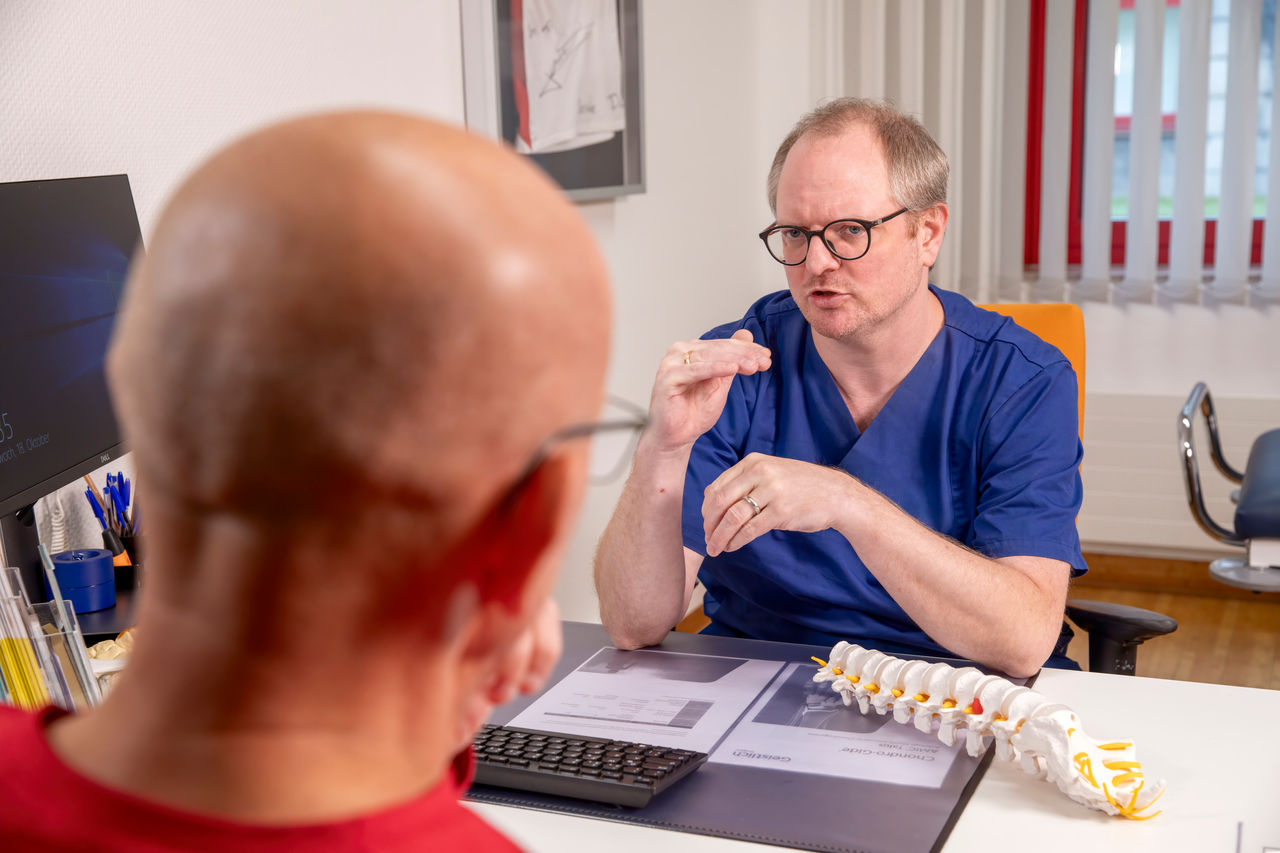
Helios St. Josefshospital Uerdingen: Help for chronic (back) pain
Prof. Dr. med. Philipp J. Slotty and Dr. med. Axel Scharfstädt are two proven experts at Helios St. Josefshospital Uerdingen. Gentle, modern procedures can be helpful for many chronic pain disorders and neurological movement disorders.
One in five people in Europe suffers from pain. For around 15 million Germans, permanent back pain, migraines or nerve pain are even part of everyday life - sometimes with major limitations.
Conservative treatment options
"If you have back pain, you don't immediately go under the knife in hospital. Surgery is always the last step,"
emphasizes Dr. Axel Scharfstädt,
"Conservative therapy with physiotherapy, injections close to the spine or sclerotherapy of the facet joints always come first. Only if conservative treatment is unsuccessful, or if there are signs of paralysis or instability, is surgery justified,"
emphasizes the experienced orthopaedic surgeon.
Minimally invasive surgery can help with a wide variety of pain problems
If conservative measures fail, this is referred to as refractory pain. In these cases, neurostimulation using an implanted pacemaker can provide relief.
Neuromodulation has been a proven therapeutic procedure for the treatment of chronic pain since the 1980s. However, there are still only a few specialists in Germany. Prof. Dr. Philipp J. Slotty is a proven expert in this field. He worked and researched at the University Hospital Düsseldorf for over a decade, interrupted by a stay abroad at the University of British Columbia in Vancouver, Canada. Born in Hamburg, he has been working at Helios St. Josefshospital Uerdingen and Helios Hospital Krefeld since the beginning of September.
The experienced neurosurgeon specializing in special neurosurgical pain therapy wants to end the often long suffering of his patients.
"With the possibilities of modern neurostimulation, we can trick the brain so that pain is no longer perceived as before. This restores quality of life."
At the Uerdingen site, the treatment spectrum includes spinal cord stimulation (SCS) and spinal ganglion stimulation (DRG) for chronic pain in the back and extremities. Occipital nerve stimulation (ONS) can be helpful for certain chronic headache disorders. But it's not just pain that can be treated with neurostimulation.
"With deep brain stimulation - DBS - we can improve movement disorders such as pathological tremors in Parkinson's disease or essential tremor,"
says Prof. Slotty. Depending on the type of procedure, the operation is performed in Uerdingen or at the clinic in the city center.
Prof. Dr. Slotty also focuses on the comprehensive treatment of chronic facial pain, in particular trigeminal neuralgia. This condition is characterized by recurring, shooting pain in the face. All standard treatment procedures such as thermocoagulation, microvascular decompression (MVD or Janetta surgery) and neuromodulative procedures are offered, as well as radiosurgery in cooperation with the Gamma-Knife Center Krefeld.
The surgical spectrum of the experienced surgeons in Uerdingen is completed by operations on the spine for herniated discs in the cervical, thoracic and lumbar spine as well as for narrowing of the spinal canal (spinal canal stenosis). If necessary due to instability, the two back experts can also stiffen individual vertebral segments in all three areas of the spine.
They also offer infiltration of joints and nerves as well as thermocoagulation procedures in Uerdingen.
Spine center for complex cases
If the causes of the pain are more complex, as in the case of a pronounced curvature of the spine or a complex tumor of the spine, these are treated at the maximum care spine center in the city centre.
How does neurostimulation work for pain?
The basic principle of neurostimulation is always the same: a thin electrode is implanted at a specific point in the body and connected to a pacemaker. This is worn under the skin like a pacemaker. The pacemaker can be controlled externally and emits electrical impulses. These impulses "modulate" the signal processing of the pain or nerve impulses.
Depending on the underlying disease, the stimulation takes place at different points in the body, usually in or on the nervous system or in the immediate vicinity of the nerves. This can be used to treat not only pain, but also other diseases such as Parkinson's disease, essential tremor or circulatory disorders.
The most common treatment indication for neurostimulation is chronic back and leg pain. A small electrode is inserted into the bone canal of the spine via a needle puncture. A small pacemaker, typically implanted under the skin above the buttocks, supplies the electrode with electricity. This current, which is a very complex electrical impulse, stops some of the pain signals on their way to the brain and the patient feels less pain. The pacemaker is programmed externally by radio and, in most cases, charged by the patient by induction, i.e. through the skin. Permanent stimulation generally achieves better and more continuous pain reduction than medication alone.
In other pain-relieving neurostimulation techniques, the nerve nodes (spinal ganglia), e.g. in CRPS, the peripheral nerves (e.g. in peripheral neuropathies) or the fine nerve endings in the skin are stimulated rather than the pain-conducting fiber tracts of the spinal cord. In rare cases, stimulation can also be carried out directly on the surface of the brain or in deep brain structures of the pain pathways, but these invasive procedures are only necessary in very selected cases.
In all cases, a thorough medical history, examination and consultation with a specialist is required to decide whether and, if so, which neurostimulation procedure is suitable.
Read more:
-
More about Helios Krefeld
-
More about Prof. Dr. med. Philipp J Slotty
-
Do you need more information about Helios Hospitals or do you want to schedule your treatment?
Please contact our Helios International Office. We will gladly advise you!
